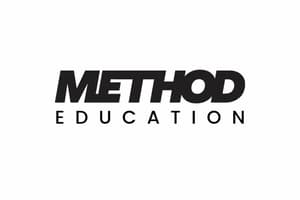Podcast
Questions and Answers
What is the main focus of the CrossFit Nutrition I Training Guide?
What is the main focus of the CrossFit Nutrition I Training Guide?
Nutrition and training
Which of the following is a section in the CrossFit Nutrition I Training Guide?
Which of the following is a section in the CrossFit Nutrition I Training Guide?
- The Science of Sickness (correct)
- Global Nutrition Guidelines
- Exercise Techniques
- Meal Prep Strategies
The guide contains a table on health markers related to body composition.
The guide contains a table on health markers related to body composition.
True (A)
Name one health marker mentioned in the guide.
Name one health marker mentioned in the guide.
What is the significance of 'Essential vs. Nonessential Fat' discussed in the guide?
What is the significance of 'Essential vs. Nonessential Fat' discussed in the guide?
What does the term 'Anthropomorphic Measurements' refer to in the context of health markers?
What does the term 'Anthropomorphic Measurements' refer to in the context of health markers?
How can decreasing body fat contribute to an individual's health according to the guide?
How can decreasing body fat contribute to an individual's health according to the guide?
What is the significance of Resting Heart Rate as a health marker?
What is the significance of Resting Heart Rate as a health marker?
What potential effect does Insulin have on chronic diseases?
What potential effect does Insulin have on chronic diseases?
What does 'Heart-Rate Variability (HRV)' indicate about an individual’s health?
What does 'Heart-Rate Variability (HRV)' indicate about an individual’s health?
Which blood lipid is specifically mentioned as a marker in the guide?
Which blood lipid is specifically mentioned as a marker in the guide?
What does C-Reactive Protein (CRP) typically indicate?
What does C-Reactive Protein (CRP) typically indicate?
What does a higher level of Triglycerides (TG) suggest about an individual's health?
What does a higher level of Triglycerides (TG) suggest about an individual's health?
Why is monitoring Blood Sugar important in assessing overall health?
Why is monitoring Blood Sugar important in assessing overall health?
Which health aspect does Body Composition analyze?
Which health aspect does Body Composition analyze?
Flashcards are hidden until you start studying
Study Notes
Introduction
- The document is the CrossFit Nutrition I Training Guide
- It is version 1.3 and was last updated on March 17, 2022
- The guide includes a disclaimer, an explanation of how to use it, an introduction, the science of sickness, health markers, and a table of contents
- The guide covers the science behind sickness, including the role of insulin and chronic disease, and various health markers like body composition, resting heart rate, and blood lipids
- The guide uses the term "sickness-wellness-fitness continuum" to describe a spectrum where individuals can be classified based on their health status
- CrossFit, LLC is the copyright holder for the guide
How to use this training guide
- The guide is designed to help learn about CrossFit Nutrition
- It is recommended to read the guide at least once before attending any CrossFit Nutrition courses
- The guide is not intended to be a substitute for advice from a healthcare professional
- The guide is subject to change
- The guide uses bold terms for key concepts, and definitions for these are provided in the glossary at the end of the guide
The science of sickness
- Explains why many people experience chronic disease and poor health
- The burden of chronic disease is high
- Insulin plays a crucial role in managing blood sugar levels
- Insulin resistance can lead to increased blood sugar, weight gain and inflammation
- Insulin sensitivity is a measure of how effectively insulin works to control blood sugar
- Improving insulin sensitivity is essential for good health
Health Markers
- Health markers are used to measure health
- Different health markers are used to assess an individual's "sickness-wellness-fitness continuum" status
- Health markers are useful for identifying areas for improvement
- Health markers can provide insights into metabolic fitness
- Body composition, resting heart rate, heart-rate variability, blood lipids, triglycerides, blood sugar, C-reactive protein, and bone density are examples of health markers
- Body composition is a measure of the percentage of body weight that is fat and lean mass
- Resting heart rate is the number of times the heart beats per minute when at rest
- Heart-rate variability (HRV) is a measure of the variation in time between heartbeats
- Blood lipids are fats in the blood, including cholesterol and triglycerides
- C-reactive protein (CRP) is a marker of inflammation
- Bone density is a measure of the strength of bones
- Health markers are not a perfect reflection of health
- It is important to consider all aspects of health, not just one or two markers
- The guide provides a table classifying body-fat percentage on the sickness-wellness-fitness continuum.
- The guide provides a table detailing health markers on the sickness-wellness-fitness continuum
Introduction
- The guide provides information and training for CrossFit Nutrition I.
- This guide is not a substitute for medical advice.
The Science of Sickness
- The main focus of the guide is chronic disease.
- Chronic disease is a significant burden with health care costs and productivity loss.
- Insulin plays a key role in regulating blood sugar levels.
- Excessive insulin can lead to metabolic dysfunction and chronic disease.
Health Markers
- Health markers are used to assess an individual's health status and metabolic fitness.
- Different markers indicate different levels of sickness, wellness, and fitness.
- Anthropomorphic measurements like height, weight, and body mass index (BMI) are important markers.
- Body composition, including body fat percentage, is a key indicator of health.
- Essential fat is necessary for organ function, while nonessential fat is stored and can increase health risks.
- Body fat percentage is associated with various health outcomes, such as cardiovascular disease and diabetes.
- Reducing body fat can improve health and lower risks.
- Resting heart rate and heart rate variability (HRV) provide insights into cardiovascular health.
- Blood lipids, including cholesterol and triglycerides, are indicators of cardiovascular risk.
- Blood sugar levels are a measure of glucose metabolism and can indicate diabetes risk.
- C-reactive protein (CRP) is a marker of inflammation, which is linked to chronic diseases.
Studying That Suits You
Use AI to generate personalized quizzes and flashcards to suit your learning preferences.




